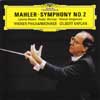Mahler Symphony no 2
Greater insights and fine sound but as Kaplan takes his life’s obsession into the studios again, is there a spark missing?
View record and artist detailsRecord and Artist Details
Composer or Director: Gustav Mahler
Genre:
Orchestral
Label: Deutsche Grammophon
Magazine Review Date: 12/2003
Media Format: CD or Download
Media Runtime: 85
Mastering:
Stereo
DDD
Catalogue Number: 474 380-2GH2

Tracks:
| Composition | Artist Credit |
|---|---|
| Symphony No. 2, 'Resurrection' |
Gustav Mahler, Composer
Gilbert Kaplan, Conductor Gustav Mahler, Composer Latonia Moore, Speaker Nadja Michael, Mezzo soprano Vienna Philharmonic Orchestra Vienna Singverein |
Author: Andrew Farach-Colton
Listening again to Gilbert Kaplan’s first recording of the Resurrection Symphony, I was reminded of the story in which, greeting the applause after conducting a performance of Mahler’s Eighth Symphony, Anton Webern lifted the score high over his head as a gesture of deference. Kaplan has long had a passionate love affair with Mahler’s Second Symphony, and although that 1987 Carlton (now Conifer) set with the LSO came fairly early into his very narrowly focused conducting career, it touchingly and often excitingly conveyed his desire to perform Mahler’s score with unflagging exactitude.
The occasion for this DG recording is the publication of a new critical edition (jointly edited by Kaplan and Renate Stark-Voit) that reportedly corrects hundreds of errors, although precious few of these are audible without the score in hand. This time around, Kaplan has the Vienna Philharmonic at his disposal, and the result is considerably more plush. How sweetly the strings croon the lyrical passage at fig 23 (CD 1, track 13, 0'46"), for example, sliding shamelessly through all those swooning glissandi. And, again, Kaplan pays scrupulous attention to Mahler’s markings. Note how a few moments later, the violins and violas actually heed the extraordinary ppppp (bar 399 – track 14, 0'25"). The recording is more expansive, too, though there are times – particularly in the finale – where the trumpets are overly prominent.
With 15 years more experience, Kaplan now handles even the most tricky transitions deftly. There are magical moments, too – the dewy texture at bar 212 in the second movement (CD 2, track 5), the intense expectation at fig 51 in the scherzo (track 13, 0'41"), and the hushed entrance of the chorus in the finale (track 25). Overall, however, I felt a strange lack of vitality. The LSO recording, despite its periodic awkwardness, sloppy orchestral ensemble and distractingly shallow soundstage, really crackled with energy and enthusiasm. This new version, for all its sonic advantages and interpretative maturity, frequently seems earthbound. The triplets at bar 38 in the second movement (track 2) aren’t nearly prickly enough, the hazy trio of the scherzo seems hurried, and the ‘March of the Dead’ in the finale (bar 196 – track 22, 0'29") needs greater ferocity. Another drawback is mezzo-soprano Nadja Michael’s tremulous tone and detached style, and she and soprano Latonia Moore are poorly matched. They pale in comparison with Maureen Forrester and Benita Valente, who graced the Carlton set. So, while Kaplan’s devotion to Mahler’s music remains an inspiration, I’m content to stick with his LSO recording – not to mention Bernstein, Rattle and Walter.
The occasion for this DG recording is the publication of a new critical edition (jointly edited by Kaplan and Renate Stark-Voit) that reportedly corrects hundreds of errors, although precious few of these are audible without the score in hand. This time around, Kaplan has the Vienna Philharmonic at his disposal, and the result is considerably more plush. How sweetly the strings croon the lyrical passage at fig 23 (CD 1, track 13, 0'46"), for example, sliding shamelessly through all those swooning glissandi. And, again, Kaplan pays scrupulous attention to Mahler’s markings. Note how a few moments later, the violins and violas actually heed the extraordinary ppppp (bar 399 – track 14, 0'25"). The recording is more expansive, too, though there are times – particularly in the finale – where the trumpets are overly prominent.
With 15 years more experience, Kaplan now handles even the most tricky transitions deftly. There are magical moments, too – the dewy texture at bar 212 in the second movement (CD 2, track 5), the intense expectation at fig 51 in the scherzo (track 13, 0'41"), and the hushed entrance of the chorus in the finale (track 25). Overall, however, I felt a strange lack of vitality. The LSO recording, despite its periodic awkwardness, sloppy orchestral ensemble and distractingly shallow soundstage, really crackled with energy and enthusiasm. This new version, for all its sonic advantages and interpretative maturity, frequently seems earthbound. The triplets at bar 38 in the second movement (track 2) aren’t nearly prickly enough, the hazy trio of the scherzo seems hurried, and the ‘March of the Dead’ in the finale (bar 196 – track 22, 0'29") needs greater ferocity. Another drawback is mezzo-soprano Nadja Michael’s tremulous tone and detached style, and she and soprano Latonia Moore are poorly matched. They pale in comparison with Maureen Forrester and Benita Valente, who graced the Carlton set. So, while Kaplan’s devotion to Mahler’s music remains an inspiration, I’m content to stick with his LSO recording – not to mention Bernstein, Rattle and Walter.
Discover the world's largest classical music catalogue with Presto Music.

Gramophone Digital Club
- Digital Edition
- Digital Archive
- Reviews Database
- Full website access
From £8.75 / month
Subscribe
Gramophone Full Club
- Print Edition
- Digital Edition
- Digital Archive
- Reviews Database
- Full website access
From £11.00 / month
Subscribe
If you are a library, university or other organisation that would be interested in an institutional subscription to Gramophone please click here for further information.




